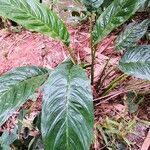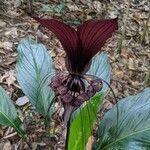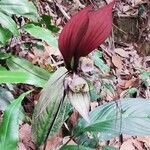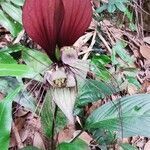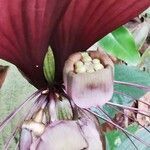Rhizomes subcylindric, thick. Petiole 10--30 cm; leaf blade oblong to oblong-elliptic, 20--50(--60) × 7--14(--25) cm, glabrous or abaxially pubescent, base rounded-cuneate to cuneate, apex shortly caudate. Scape long; involucral bracts 4, dark purple, outer 2 ovate-lanceolate, inner 2 broadly ovate; umbels 5--7(--18)-flowered. Perianth lobes purplish brown, lanceolate. Stigma 3-lobed. Berry purplish brown, ellipsoid, ca. 3 cm, fleshy, 6-ridged, with persistent perianth lobes. Seeds reniform. Fl. and fr. Apr--Nov.
A herb. It keeps growing from year to year. It grows 60 cm high. The rhizome or underground stem is cylinder shaped. It is 8-15 cm long. There are 4-14 leaves. The leaves are 10-35 cm long. The leaf blade is entire and oval. The flowering stalk is 45-80 cm long. There are 4 bracts in 2 pairs at right angles. The flowers are purple and 1-3 cm long. The fruit are shiny and purple-black. The seeds are kidney shaped. They have deep furrows.
